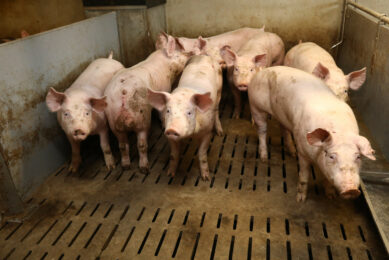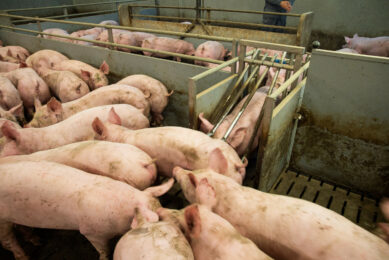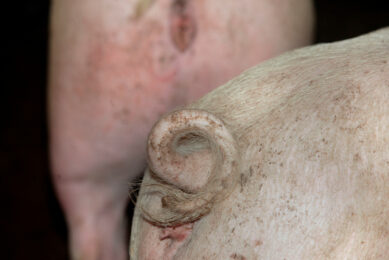JRP: Carbon footprint, carcasses and coughs

The 55th edition of the French Swine Research Days (JRP) showcased a variety of different subjects in pig research. Some notable research revolved around the carbon footprint of swine production, the classification of swine carcasses and cough monitoring. Plus: how has the French swine herd changed in the last 10 years?
In a review of the impact of dietary protein on the carbon footprint of pig production, Léa Cappelaere from Laval University in Québec, Canada, explained that pig production is responsible for about 10% of the greenhouse gases (GHG) emitted by all livestock in the world. Feed production and manure management contribute 60% and 30% of these emissions.
She presented data of a life cycle assessment (LCA) of feed production, based on 10 published experiments in a study that Metex Animal Nutrition, Paris supported.
She showed that the carbon footprint can be reduced by 65 kg CO2 eq./tonne of feed for each percentage point decrease in dietary crude protein. That effect was obtained by gradually replacing the feedstuffs with the highest impact (i.e. soya bean meal and soy oil) with cereals and feed-grade amino acids, while maintaining animal performance.
However, these benefits depend strongly on the available and usable feedstuffs, the choice of environmental assessment databases, the context and the potential for reduction. By integrating recent knowledge, a complete LCA at the exit of the farm indicated that decreasing the impact by about 10% per kg of pig was possible when aiming for a 1 percentage point decrease in dietary crude protein.
Classification of pig carcasses
Gérard Daumas of the French Pork & Pig Institute (IFIP) gave a presentation on the classification of pig carcasses according to muscle content in France and the European Union (EU). He explained that for half a century, the main requirement for quality has been the lean meat content, which is predicted in slaughterhouses by grading methods authorised by the EU. The definition of the EU benchmark changed a few years ago. France will have to incorporate that change when it reviews its classification methods.
New models of devices
New models of devices – using ultrasound, vision or magnetic induction – have appeared on the market. This allows some devices to access new measurements. Daumas said, “The prediction error of the methods is still quite high, even for the most precise methods.” He added that the factors with the biggest influence on the prediction equations are sex and genetics, with non-negligible biases affecting different mating types and genetic types.
Currently, 8 member states predict the “carcass muscle percentage”. 3 or 4 others are expected to join them in 2023, with France to follow soon. One of the challenges will be to reduce the biases between subpopulations, he concluded.
Early cough detection
Coughing episodes can be difficult to detect in swine herds. This can delay implementation of appropriate treatment. Sound-based monitoring technology has been developed in the past few years, based on collecting pig sounds 24 hours a day. Its algorithm transforms sound into a score (0–100): the Respiratory Health Score (ReHS). According to that score, the device changes colour (green, orange or red), alerting the farmer to respiratory disorder.
Gwendoline Hervé, attached to IFIP, presented about this study, which is part of the Sino-European Healthy Livestock project. She explained, “The objective of our experiment was to describe dynamics of the ReHS in a fattening unit and determine whether the ReHs could help predict a coughing episode caused by a specific pathogen or group of pathogens, a potential decrease in performance or a decrease in the lung score at the slaughterhouse.”
Sensors for cough counting
Therefore, they installed 4 sensors in 4 fattening rooms at the IFIP experimental farm in Romillé. They connected these to a router through a wifi network. The experiment lasted 11 months and involved 992 animals. Each time the monitor alarm turned red in a room, coughs were counted. The research team collected oral fluids in the 3 pens showing the most signs of illness. This ensured that they could look for specific pathogens via PCR analysis (Porcine Reproductive and Respiratory Syndrome, Mycoplasma hyopneumoniae, SIV, PCV2, PCV3 and Actinobacillus pleuropneumoniae). The team also collected carcass characteristics and lung scores at the slaughterhouse to assess the severity of lesions.
This study reached 4 conclusions:
- ReHS drops and orange and red alarms corresponded well to phases of respiratory disease. Cough counts in livestock confirmed the reliability of the system;
- The monitoring over time of this index makes it possible to visualise the spread of cough between rooms;
- The frequency of poor lung scores at the slaughterhouse is higher for bands that had a high coefficient of variation of the ReHS the last month of fattening;
- There was no correlation between performances and the data collected by the sound sensors.
Hervé concluded, “It would be interesting to continue the trial with a greater number of bands and monitoring from post-weaning to explore the predictive nature of ReHS throughout the growth phase of pigs.”
10-year census
Christine Roguet from IFIP gave another interesting presentation. Every 10 years, the agricultural census provides an overview of French agriculture by collecting more than 900 sets of data from all farms. In 2020, mainland France had 389,779 farms, which is a 20% reduction since 2010. Half of these – 167,000 farms – had livestock activity. That amount had dropped by 24% in that decade.
Remarkably, the decrease in the number of farms with at least 1 pig had slowed down. In 2020, that number stood at 13,048 (a decrease of 42% compared to 2010). Nearly all pigs are reared on 8,448 farms that contain more than 100 pigs or 20 sows. Of that amount, 4,426 farms had sows on-site.
The decrease in the total number of pigs is also slowing down: 13.3 million pigs in 2020 (-3.5% compared to 2010 – the previous decade showed a decrease of 7.1%). The same applied to the number of sows, which was 955,795 in 2020 (a 14.3% decrease compared to 2010). With 56.3% of France’s pigs, Brittany remains the leading pig-production region, but the decline in the number of pigs is larger there.











